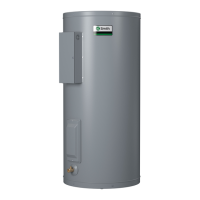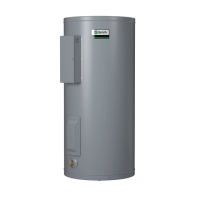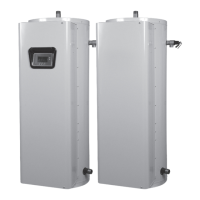Commercial Electric Water Heater Use and Care Guide • 17
Most water heater models
contain energy saving heat traps in the
inlet and outlet connecons to avoid
the circulaon of hot water within the
pipes. Do not remove the heat traps.
3
Connect the hot water supply
using 3/4 inch (19mm) NPT to
the hot water outlet. Follow
the same connecon guidelines as for
the cold water supply.
4
Install insulaon (or heat
tape) on the water pipes
especially if the indoor
installaon area is subject to freezing
temperatures. Insulang the hot water
pipes can increase energy eciency.
5
Double check to make sure
the hot and cold water pipes
are connected to the correct
hot and cold water ngs on the
water heater.
6
If needed, install (or adjust) a
Pressure Reducing Valve to
50-60 psi (345-414 kPa) and
install a Thermal Expansion Tank.
Figure 15 - A Pressure Reducing Valve is
required if the plumbing system’s water pressure
is above 80 psi (552 kPa).
Figure 16 - The Thermal Expansion Tank should
be pressurized with air to match the incoming
water pressure.
To remove air from the tank and allow
the tank to ll completely with water,
follow these steps:
1
Remove the aerator at the
nearest hot water faucet. This
allows any debris in the tank
or plumbing system to be washed out.
2
Turn the cold water supply
back on.
Figure 17 - Fully open the cold water supply
valve.
3
Open a hot water faucet and
allow the water to run unl it
ows with a full stream.
4
5
Close the hot water faucet
and replace the aerator.
6
Check inlet and outlet
connecons and water pipes
for leaks. Dry all pipes so that
any drips or leaks will be apparent.
Repair any leaks. Almost all leaks occur
at connecons and are not a tank leak.
INSTALLATION

